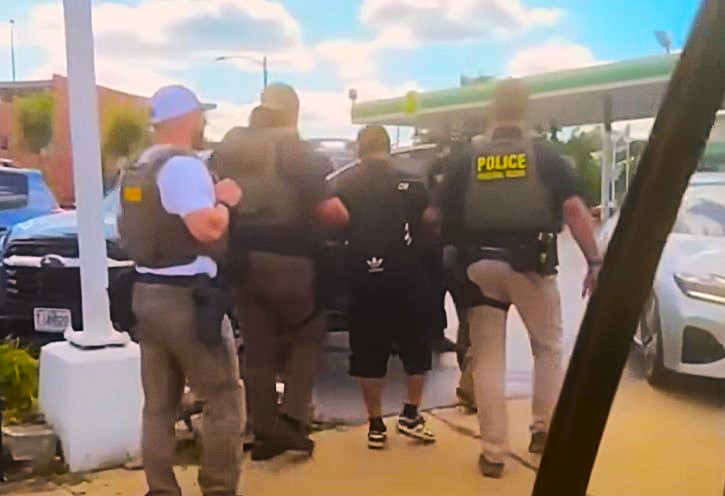In recent days, communities on Chicago’s southwest side have begun to feel the effects of a ramped-up immigration enforcement operation by the U.S. Immigration and Customs Enforcement (ICE). The operation, referred to as Operation Midway Blitz, has led to the detention of multiple individuals, causing heightened tensions and fear within local neighborhoods.

The presence of federal immigration agents has sparked concern among community leaders, local officials, and immigrant rights advocates, who claim that the enforcement actions are not only targeting criminals but are instilling fear in immigrant communities at large.
ICE Detentions and Local Reactions
At least five individuals from the southwest side of Chicago were detained during an ICE operation on Sunday. The detentions occurred in public spaces, such as bus stops and sidewalks, which has left many residents on edge. One of the individuals detained was a street vendor from the Archer Heights area, a neighborhood known for its large immigrant population.
Immigration advocates have pointed out that there is a noticeable absence of street vendors in the area, with many people now afraid to go about their daily activities for fear of being detained by federal authorities.
A local resident, who shared their observations, expressed their concern after noticing the absence of street vendors while dropping their children off at school. “People are afraid. People are scared,” the resident said, reflecting the sentiments of many who are currently grappling with the fear of detention.
This shift has been attributed to the recent ICE operation, which immigration advocates claim is disproportionately affecting immigrant communities that have already been vulnerable due to their status.
The Role of Local Officials and Community Advocacy
Local leaders, including Alderman Halo Gutierrez of the 14th Ward, have been vocal in their opposition to ICE operations in the area. Gutierrez confirmed that the ICE detentions took place in multiple locations, including near 50th and Palaski, 49th and Archer, and 47th and Archer.
Two other detentions occurred outside her ward but were still part of the larger operation. The arrests have raised concerns among community leaders, who argue that these actions are part of a broader campaign to intimidate rather than address any actual criminal activity.
In response to the detentions, Gutierrez and other local officials have urged residents to familiarize themselves with their rights when dealing with immigration authorities. They emphasized that local law enforcement is not obligated to assist ICE agents in detaining individuals, and citizens should be aware of the protections available to them. These community leaders continue to stress that solidarity is key to resisting the tactics being employed by federal immigration enforcement.
“Latinos in my district are being racially profiled,” Gutierrez said, adding that the community would continue to fight back in solidarity. “We will fight back together because that’s what solidarity looks like and that’s what community power looks like.” Her comments reflect the sentiment that the operation is targeting vulnerable immigrant populations based on racial profiling, rather than focusing on actual public safety threats.
Federal Justification for the Operation
On the other side, the White House and ICE officials have defended the operation, with ICE acting Director Tom H. Homeman asserting that the purpose of Operation Midway Blitz is to bolster public safety by removing individuals who entered the country without following the proper legal channels.
Homeman emphasized that the goal was not to criminalize immigrants seeking better lives but rather to prioritize the removal of those who pose a public safety threat. “We’re asking their cops to work with our cops to help us take public safety threats off the street,” he said during a statement.
Homeman also acknowledged the plight of individuals seeking refuge in the U.S. but made a distinction between people who “cheated the system” and those who are fleeing persecution and seeking asylum. This statement, which positions the current operation as necessary to protect public safety, has been met with criticism from immigrant rights groups who argue that the enforcement is causing harm to entire communities, rather than targeting individuals involved in criminal activity.
Community Support and Legal Resources
As tensions rise, local advocacy groups and immigrant organizations have mobilized to provide resources and support to those affected by the ICE operations. One of the resources being offered is a hotline specifically for immigrant families, providing a way for them to report ICE sightings and seek assistance in case they or their loved ones are detained.
Local officials have encouraged residents to save the hotline number (855-435-7693) in their phones, as it can provide vital support during these stressful times.
Moreover, community leaders are stressing the importance of knowing one’s rights when interacting with ICE officers. Advocacy organizations are also pushing back against what they view as racial profiling, with many members of the Latino community feeling particularly targeted by these operations.
The broader response from the community has been one of solidarity and resistance, as local leaders and residents continue to work together to ensure their neighborhoods remain safe and welcoming.
Conclusion
The escalation of ICE operations on Chicago’s southwest side has brought attention to the growing tension between federal immigration enforcement and local communities. The fear and uncertainty surrounding these operations have made it difficult for many immigrants to go about their daily lives.
While federal officials argue that these actions are necessary for public safety, local leaders and advocacy groups continue to voice concerns about the impact on immigrant communities, who fear that these operations are more about intimidation than crime prevention. As the situation unfolds, it remains to be seen how the community will continue to respond to the growing presence of ICE in their neighborhoods.

